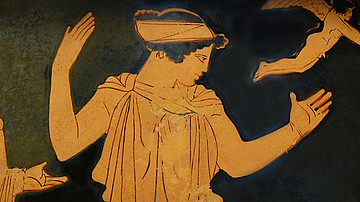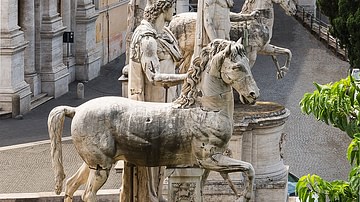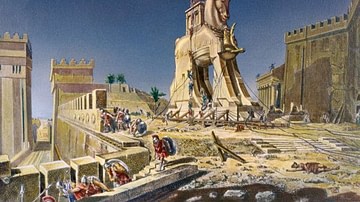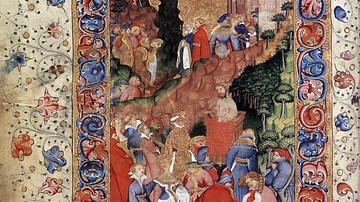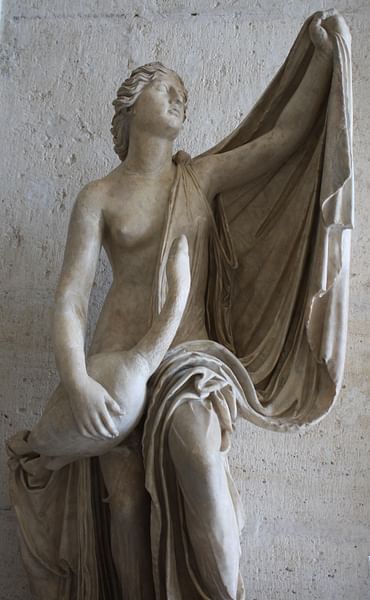
Leda is a figure from Greek mythology who was famously seduced by Zeus when he took the form of a swan. She was a queen of Sparta and mother of beautiful Helen who sparked the Trojan War, and the Dioscuri twins. Leda and the swan was a popular subject for both Greek and Roman artists and is frequently seen in ancient sculpture, pottery, and mosaics.
Genealogy
Leda was the daughter of King Thestius of Pleuron in Aetolia. She was the wife of Tyndareus, the king of Sparta, and together they had various children including Helen, who would fall in love with Paris and cause the Trojan War, the Dioscuri hero twins of Castor and Pollux (aka Polydeuces), Clytemnestra (future wife of King Agamemnon), Timandra, and Phylonoe.
Leda & the Swan
Leda was famously seduced by Zeus when the king of the Olympian gods took the form of a swan. The result of this union, which occurred on the banks of the River Eurotas, was an egg from which the beautiful Helen and Polydeuces were born. The second twin son, Castor, was born to Leda's husband Tyndareus on the very same night the egg hatched. This explains why one of the twins was considered mortal and the other immortal, but some writers, notably Homer and Pindar, have the twins daily share the boon of immortality. As a climax to the story, Leda is granted immortality by Zeus and transformed into the goddess Nemesis. However, in Homer's Odyssey, the hero Odysseus sees Leda on his tour through Hades.
The Nemesis Version
In an alternative version of the myth, it is the goddess Nemesis who is pursued by Zeus (although an early version has the roles reversed). The goddess transforms herself into a fish and swims away in order to escape his attentions, but the amorous Zeus is not deterred and changes into a beaver to better pursue his prey. Nemesis next changes into various other creatures including a hare, a bee, and then a mouse, but Zeus merely becomes a swifter or more predatory creature each time until, finally as a swan, Zeus captures Nemesis while she is a goose. In some versions, an extra twist of deceit is added when Zeus appeals to Leda's pity by pretending he is being pursued by an eagle and then ravishes her.
After the pair has lain together, Nemesis flees to Sparta where she lays a purple-blue egg in the marshes outside the city. Leda finds the egg one day (or a shepherd does and gives it to his queen), and she takes it back to the palace where she hides it in a chest. From the hatched egg Helen is born, as in the other version of the myth, and Leda raises the girl as her own daughter. A third version has Hermes throw the egg between Leda's thighs while she is on a stool, presumably while giving birth to Polydeuces.
Leda in Art
Leda embracing a swan or holding an egg was a scene frequently represented in Greek art. A celebrated marble statue of Leda holding a swan is now on display in the Capitoline Museums of Rome. Dating to the Roman period, it is thought to be a copy of a Greek original sculpted c. 400 BCE and the earliest known representation of the swan myth with Leda. Zeus with Leda and an egg sitting on a throne (but no swan in sight) is seen on Attic red-figure pottery of the mid- to late-5th century BCE.
A c. 425 BCE bas-relief from the Temple of Nemesis at Rhamnus depicts an adult Helen being brought from Nemesis to Leda. It is currently on display in the National Museum of Stockholm. Helen emerging from an egg appears on red-figure pottery from Apulia and Campania during the 4th century BCE. Finally, Leda being pursued by a swan is depicted in the central panel (emblemata) of a Roman period mosaic from the sanctuary of Aphrodite at Palaipafos on Cyprus and is typical of the more erotic depictions of the swan myth from the Late Classical period onwards.

